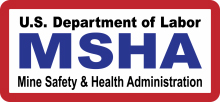MSHA or OSHA?
Intense federal regulation of workplace safety and health began when Congress introduced civil penalties for mines with the Federal Coal Mine Health and Safety Act of 1969, and for other employers with the Occupational Safety and Health Act of 1970.
The Coal Act was amended in 1977 to become the Federal Mine Safety and Health Act, with enlarged sanctions. In 2006, the Mine Improvement and Emergency Response Act further raised requirements and sanctions for mines.
The Occupational Safety and Health Administration (OSHA) and the Mine Safety and Health Administration (MSHA) are Department of Labor agencies. Although MSHA’s budget approaches OSHA’s, the industrial community MSHA regulates is limited to roughly 12,000 mining and processing locations. OSHA regulates employers everywhere else. Some federal funds support optional state OSHA programs that take on enforcement of federal requirements.
Based on entirely separate laws, the jurisdiction of the two agencies is mutually exclusive. Occasionally, mine inspectors will claim a right to inspect a location not previously considered a mine. Similarly, OSHA inspectors claim jurisdiction at a site MSHA regulates.
In California, the Department of Occupational Safety and Health inspects mines, but it relies on non-federal funds for this activity. States may enforce mine safety, but without conflicting with MSHA.
To minimize jurisdictional conflicts, there is a longstanding memorandum of understanding whereby the two agencies have designated which types of facilities are and are not mines. However, this agreement has not anticipated every permutation. To the present day, there are frequent occasions when law, policy and legal decisions must be consulted to evaluate which agency has jurisdiction.
One versus another
The laws and regulations of each agency are different. While both agencies have extensive rules to prevent injuries, the approach and requirements for each are distinct. As a simple example, OSHA requires employers to keep a log on site of all injuries and illnesses. MSHA requires that every injury and illness must be reported to MSHA. The repercussions for violations and rights of judicial review also vary between the agencies.
One of the greatest enforcement differences is how often inspections are conducted. Under MSHA, surface mines are inspected no less than twice a year and underground mines are inspected no less than four times a year. Employers under OSHA may never experience an inspection. Apart from certain programmed inspections, the major triggers for OSHA are fatal accidents and disasters and hazard complaints.
‘Mines’ subject to MSHA
Mines include land from which minerals are extracted from natural deposits in non-liquid form for their intrinsic value, unlike construction and landscaping. Oil and gas operations are not subject to MSHA. Neither are operations that dissolve minerals for extraction.
However, placer mining, dredging and creation of slurries for extraction are subject to MSHA. In such operations, minerals are suspended in liquids, but they are not converted to liquid form.
Mine properties are not defined by metes and bounds, but rather by function. A company may own 100,000 acres of land, but perhaps part of it is farmed, part is a quarry, a crusher and stockpiles – and yet another part is an asphalt facility. MSHA jurisdiction extends to the quarry, crusher and stockpiles, but it does not include areas functionally distinct from mining.
In addition, MSHA regulates roads leading to mines unless they are public (federal, state or county). Roads privately owned are under MSHA jurisdiction if they serve the mine, even though they may also provide access to farm, asphalt areas or other private properties.
Mining includes “mineral milling,” even if not co-located with an extraction site. A cement plant is subject to MSHA even if it ships in the limestone and other minerals that go into making the cement. Mineral milling is deemed to include the kiln, cooling and processing of clinker, and storage of finished cement.
But there are limits. If the finished cement is used to manufacture concrete structures, such as culverts, this is no longer mining under MSHA, but manufacturing under OSHA. Similarly, a gypsum mine will extend through product milling, but when product is transferred to a wallboard manufacturing plant on the same property, it goes from MSHA to OSHA.
Who’s responsible?
All employers on mine property are subject to MSHA requirements. MSHA may hold some employers directly responsible if they are independent contractors deemed to be operators at the mine. By law, mine operators are responsible for all compliance, but independent contractors may be held jointly or separately liable as “operators” in their own right.
Visitors, outside truckers, outside delivery, repair and service providers are all under MSHA jurisdiction. If they are exposed to hazards or if they commit violations, they will not be held responsible. The mine operator will be responsible. Such visitors may be subject to OSHA everywhere, but at a mine everything is under MSHA.
Take note
While both MSHA and OSHA have extensive rules to prevent injuries, the approach and requirements for each are distinct.











